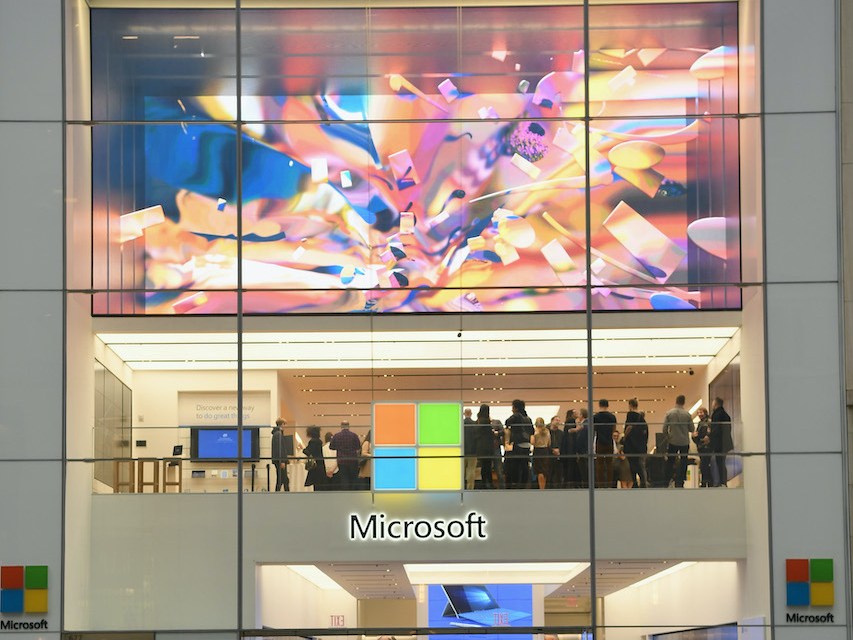Why Microsoft is closing most of its experiential stores

The Microsoft Store is the latest retail victim to fall during the pandemic. Last week the tech giant announced its answer to the Apple store, which first opened in 2009, will shutter with the closure of 83 international stores.
In its announcement, the company said that Microsoft Store physical locations “will result in a pre-tax charge of approximately $450 million,” or $0.05 per share, and will be recorded as part of the fiscal quarter that ended on June 30. The sum is expected to mainly consist of “write-offs and impairments.” In spite of shedding the majority of its dead weight, Microsoft isn’t giving up on physical retail all together. The company confirmed it will keep four “Experience Centers” open: New York City’s Fifth Ave. flagship, London’s Oxford Circus, Westfield Sydney and the Redmond, Wash. Microsoft campus location.
The experiment’s results were undoubtedly fast-tracked by the pandemic, with all Microsoft stores having been closed since March. But the stores highlighted a major branding problem for the computing giant: at its core, Microsoft is essentially a wholesales goods company, with a limited history in selling them directly to end consumers. These stores were aimed at representing Microsoft and its growing offerings in a new, more consumer-facing light, but ultimately they didn’t pan out.
While the failure to reopen is fast becoming common in the coronavirus era — the latest weekly report by Yelp shows that 35% of retail closures are “indicated as permanent” — Microsoft’s retail woes are nothing new.
A rush to retail
Dedicated physical stores have long been a pain point for computing companies, with Microsoft following in the steps of Dell and IBM. For example computer manufacturer Dell opened proprietary kiosks in 2002, only to abruptly close all 140 in early 2008 after striking a deal with third party seller Best Buy.
But despite the trendy minimalist design and gaming lounges, Microsoft stores never seemed to attract the sales-driven foot traffic nearby Apple stores did. The idea was to position the stores as welcoming hubs for product testing, as well as offer customer service.
The big problem was Microsoft’s presence as a more utility-focused software leader, said Sanchit Vir Gogia, chief analyst and CEO of Greyhound Research. “One of the longest standing battles for Microsoft has been an identity crisis in the hardware space,” he explained; despite significantly investment in shiny gadgets through the 1990s and 2000s, the company’s revenue still mostly comes from its software products
Indeed, enterprise software has long been a major facet of Microsoft’s business. One of its biggest recent launches has been workplace messaging service Teams — a top Slack competitor. This focus on corporate clients was also evident in 2016, when Microsoft acquired professional social networking platform LinkedIn. These moves have been deemed successful ventures, yet none of these popular programs mesh well with physical retail environments.
In the early days, the stores were meant to showcase Microsoft’s myriad attempts to compete with Apple. Its iPod and iTunes competitor, Zune, failed catch consumers’ interest in the early aughts. The introduction of the popular tablet-PC hybrid, the Surface, in October 2012 was another attempt to take on hardware. After that, the company quickly expanded into Europe and Asia, and at its peak had over 116 global locations.
This latest decision to scale things back will mark a returned reliance on third party retailers to sell physical products, which have historically been hit or miss for the company. The latest gadget to fall victim of this was the Windows smartphone, which Microsoft finally killed in December. But with a slew of retail partners — including Target, Walmart and Best Buy, among others — its gaming consoles and tablets will still have a big presence at physical stores.
A downsized “experience”
Still, all is not lost, As previously mentioned, four major Microsoft locations will survive to serve as “reimagined” stores, including the London flagship, which opened exactly a year ago following two years of planning. When it does reopen, the three-story flagship will continue to act as a destination for the Surface devices, mixed-reality headset HoloLens, and of course, the Xbox.
This could end up boding well for the company, as it scales back retail ambitions and shifts focus to e-commerce. Vir Gogia said the idea has always been to use these high-touch stores to “better position products against Apple.” That’s especially important for Xbox, Vir Gogia noted, “an area where Apple has no formidable presence.”
Despite the limited success that Microsoft has had in brick and mortar, the effort did help put a serious stamp on its hardware business ambitions. The stores’ feedback loop and brand awareness could also be credited with pushing design further, said Vir Gogia. In recent years, competing for Apple customers has resulted in successful devices, like the Surface Pro range and its Microsoft Arc.
Microsoft’s shuttering proves that when it comes to tech companies’ luck with brick and mortar, Apple may be an anomaly. For everyone else, it’s often thought of as giving the necessary evil a try.

